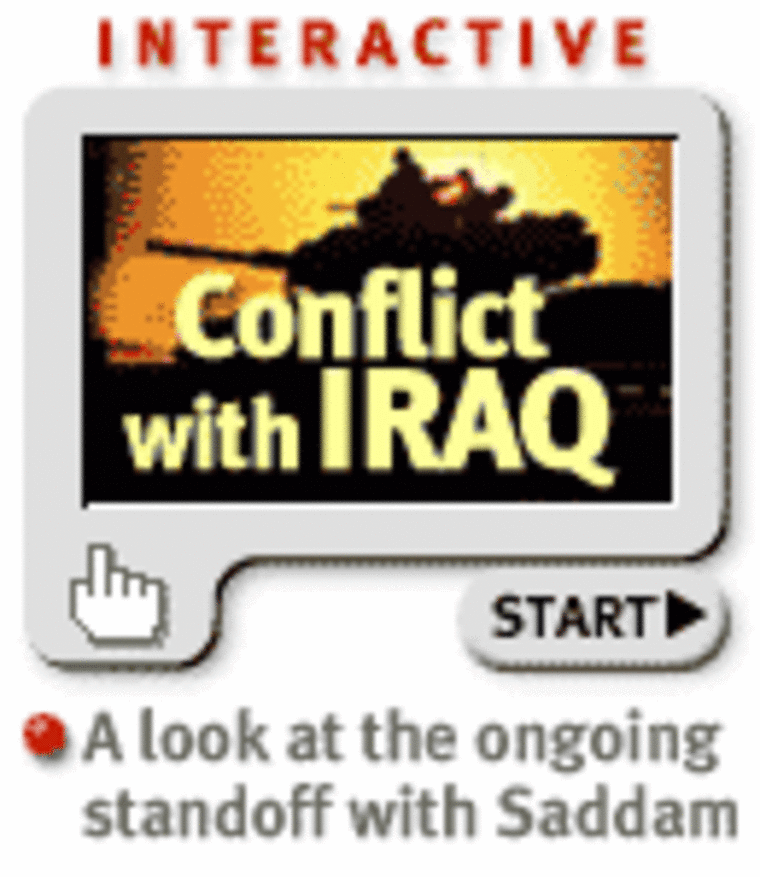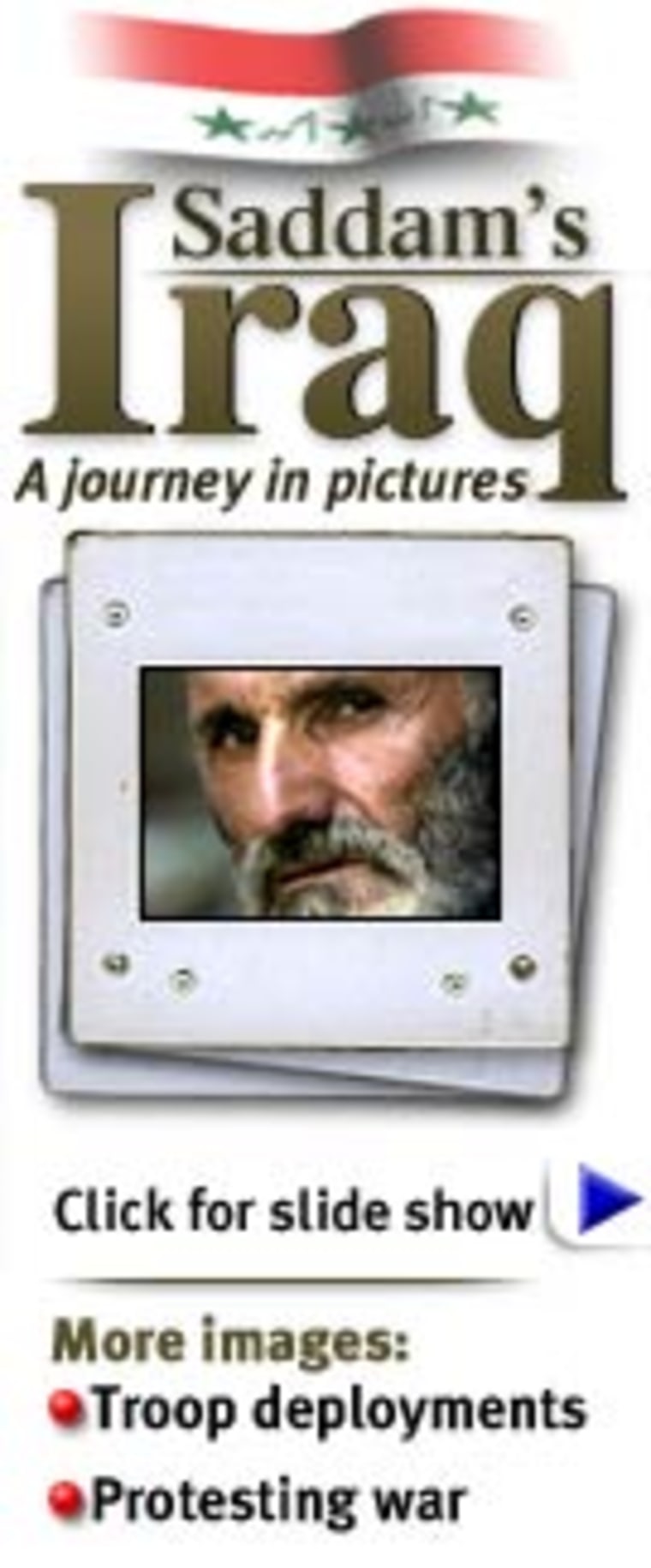They are the gold-plated living memorials to the 20-year reign of Saddam Hussein, enormous in scale, exquisite in material and opulent in taste — the 100 palaces and “VIP luxury residences” Saddam has built across Iraq. U.S. officials and a former U.N. inspector say they also are perfect hiding places for weapons of mass destruction.
THE PALACES, say U.S. and U.N. officials, are the only places in Iraq that are secure enough, large enough and protected enough to conceal not just documents about the development of weapons, but the weapons and weapons material themselves.
“It would be ideal for the storage of weapons of mass destruction,” says former chief U.N. inspector Richard Butler, now an NBC analyst. “They were places directly associated with the president of Iraq’s special security apparatus — the people who both protect him and protect the weapons of mass destruction.”
So far, only two of Saddam’s palaces — the Republican Palace, Iraq’s White House, and the Sijood Palace, Iraq’s executive office building, have been examined during the current round of inspections, but the United States wants inspectors to be more aggressive — and soon.
They won’t lack for locations. Of the 100 palaces built by Saddam, half were constructed after the Gulf War at a rate of around five per year, said U.S. officials, speaking on condition of anonymity.
During the war, seven were struck by coalition bombs; all were rebuilt.
The total construction cost, as estimated by United States intelligence: $2 billion. “We based it on regional construction costs,” said one official, “and that doesn’t include the furnishings.”
The palaces range in size from villas to one, in Saddam’s home town of Tikrit, with an area 50 times that of the White House or Buckingham Palace. In Baghdad, there are five spectacular palaces. In Jabul Makhul, much of the palace built there is underground.
In addition, Saddam has refurbished older palaces, including the 12th century Abbasid Palace in central Baghdad.
Between 1991 and 1995, when Iraqis lost two-thirds of their income and the United Nations was searching for weapons of mass destruction, the pace of construction accelerated.
“You have to remember this was at a time when Iraqi officials were complaining to the United Nations about a housing shortage” said one U.S. official.
The U.S. State Department says in a report out this week on Iraqi disinformation that the cost of Saddam’s palaces was more than the $1.74 billion the World Food Program spent in 2001 to deliver 660,000 metric tons of food to 77 million people worldwide.
Entifadh Qanbar, an Iraqi construction engineer who worked on three palaces during the Iran-Iraq War in the late 1980s and now lives in suburban Washington, says the palaces symbolize ego and power.
“People are under the impression here in the United States and the West that the palaces are residences for the president,” said Qunbar. “This is not the case for Saddam. For the bigger part, the palaces are a show of business for Saddam, a show of his existence and power. And the second part, palaces for Saddam. Each palace will occupy huge land of area and it will contain barracks for his bodyguards, training camps within the palace, depots for weapons, depots for weapons of mass destruction, prisons, torture chambers.”
Qunbar says the buildings are double-walled to withstand explosive charges, and underslung with warrens of tunnels.
But there are also parks for the children of loyalists. At the Republican Palace, a water park features small man-made lakes connected by a network of canals. There are restaurants and boat docks.
At Lake TharThar, north of Baghdad, there is a giant Ferris wheel and a pendulum along with a merry-go-round and a resort village of more than 100 condominiums, all near Saddam’s Green Palace.

“Diplomatic officials who have visited the palaces tell of a world of splendors not seen even in European palaces that have long since become museums,” said one U.S. official.
“One described the grounds of the palace at Basra as ‘more extensive and sophisticated than Versailles, filled with exotic flowers and shrubs.’ ”
Each palace features multiple big-screen televisions and elaborate digital sound systems that fill each room with the “ubiquitous sound of Iraqi Muzak.”
All of the palaces are appointed with gold faucets, silk rugs and marble. A palace in Mosul has 50-foot waterfalls inside.
“Furniture has to be made of the best woods in the world, linens has to be gold weaved, all doors has to be super solid teakwood, expensive wood,” said Qunbar. “Accessories for bathrooms has to be gold plated, yes. I mean ... money is of no concern. Me, as an engineer, we learned in school we have to balance between quality and budget. That was not the case here.”

If Saddam didn’t like the choice of materials, “things could be trashed away and replaced with something else and it’s not a big problem. So it was something that [was] a very unique experience for an engineer,” said Qunbar.
Butler, who visited several of the palaces during his early days as an inspector, said: “What they all have in common is size and bombastic character — you know grand — the sorts of things that you would expect a dictator to build. Monumental would be a nice way of putting it.”
Since 1995, the pace of construction has slowed a bit, but Iraq still has built another 30 in the past seven years, by U.S. estimates. Saddam once joked that the United States was underestimating the number.
Iraqi officials have said the palaces are needed because the Iraqi president must move constantly to avoid being targeted by U.S. aircraft. U.S. officials say there is nothing to counter Iraqi dissidents’ claims that Saddam never sleeps in one place for more than two nights.
Butler says that U.N. inspectors have long believed that the palaces mainly are used to store weapons and related documents. He cited the palace at Mosul as an example.
“This was a place where our intelligence information and this — the overhead high-altitude imagery — led us to the view that there was an extraordinarily high possibility that important materials were hidden underground here,” said Butler. “And specifically we thought — missile materials.”
Another example, he says, was Radwaniyah, a large palace still under construction near Saddam International Airport.
“This palace — associated as it is with water, isolated by these approach roads — was it seemed to us to be an ideal place to store weapons — under the palace or even under the water,” he said. “I remember that we were very concerned to try to look underwater in the Radwaniya area because we had reason to believe that prohibited weapons materials could’ve been stored under the palace, under the water, and in any number of the buildings in that complex.”
Security on the construction sites demonstrates how vigilant Saddam’s guards are, says Qanbar.
“I’ll describe this to you by one incident,” he said. “We were pouring concrete for the swimming pool. We do it after 10 p.m. in Iraq because, especially in the summer, you cannot pour concrete in hot weather and one of the workers opened his cigarette pack and he pulled off this cellophane, metal paper and he threw it in the concrete while they were pouring.
All of a sudden I see half a dozen of Saddam’s special security organization, his bodyguards jumped in the concrete, picked this guy up, beat the hell out of him, dig the concrete with their hands to pick this piece of paper that he dropped because they were afraid he dropped something harmful!
“This guy has to be taken out, and he disappeared.”
Hussam Khadori, one of Saddam’s architects, recently was killed, not long after he talked to French documentary makers about his designs for the palaces.
Robert Windrem is an investigative producer for NBC News, based in New York.